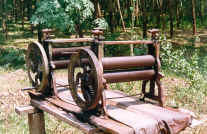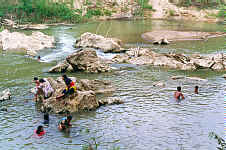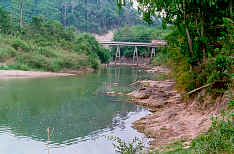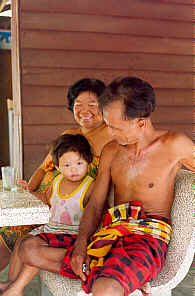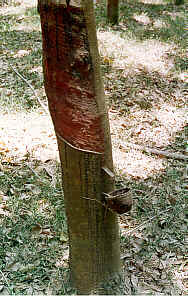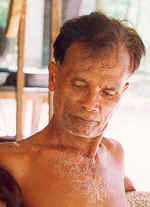
ON-LINE
Please E-mail us at:
Copyright�1998, The NESSThai
�
Network for Environmentally- & Socially-Sustainable Tourism (Thailand) |
Rubber Planters: Trang, Southern Thailand�� |
||
| If you take the first small track
to the right, just after crossing the bridge over the Ta Pratu stream on the road between
Trang and Houay Yod, the track will lead you past a half dozen or so rubber planters�
houses, through the plantations, to the house of "Lung" Tuan and "Ba"
Yupin. Their wooden house doubles as a small store selling snacks and drinks, soaps, shampoo and other essentials. On the day we arrived, "Lung" (or uncle - a term of respect for elderly men in Thailand) Tuan and "Ba" (Aunt) Yupin were busy building a small "sala"; something like a summer house raised on stilts. We introduced ourselves, and told Lung Tuan and Ba Yupin we would like to take some photographs and ask them some questions about themselves. They invited us to sit with them in the shade by their house, and Ba Yupin brought some cold water. It was a steamy April day and we were grateful. This year, less rain than usual has fallen in the Southern region, and less frequently. Ba Yupin's grand-daughter, Nain, sat between her grandparents and played shy with the strangers: watching us intently and then hiding behind her grandmother�s arm or shoulder. When we started to take photographs, Ba Yupin and Lung Tuan laughed a little shyly. "We�re not dressed for it." "I don�t even have my shirt on". "Never mind, you want to tell our story, and we�re country people. Not so civilised." Behind the house a limestone cliff rises up, with the rubber plantations of Lung Tuan and his neighbours at its base. Lung Tuan has lived in this area all his life. The fields he tends and plants with rubber trees were cleared of forest by his parents. His children now help him work the plantations. Ba Yupin is also the child of rubber planters from Trang, but she lived in a nearby district before she married Lung Tuan. Lung Tuan told us of his typical day. Rubber planters begin early, well before the sun rises. The latex flows best when the air is cool and there has been rain. Lung Tuan sometimes begins his rounds of rubber tapping ("kreed yang") as early as 2 a.m. Once the bark has been cut, the latex flows into a small cup hanging from the trunk. There is a lot of variation between trees, and some trees will produce enough latex to fill a cup, while others will barely produce enough for the cup to half fill. A tree�s most productive years are between 7 and 20 years. After 20 years, the planters usually fell the trees and sell the wood. The latex in the cups is collected in buckets and then poured into trays through a filter and washed. Once the latex has been cleaned, it is laid on the ground, where the rubber growers flatten it with their feet into sheets. The sheets of latex are taken and passed through a mangle to squeeze out the remaining water, and then they are hung out to dry and to cure in the sun. Before curing, the latex is a soft creamy white. Once it has cured in the sun for several days, it turns a deep yellow-brown. It is the cured latex which fetches the best prices. 1.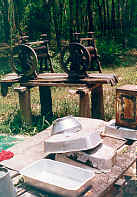 � �
2. 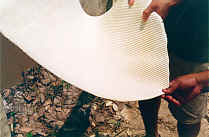
On the day we visited Lung Tuan and Ba Yupin, it had been very hot and very dry. They had only collected enough latex to make four sheets which were hanging out to cure on a line near their house. September, which has the highest rainfall, is the most productive month. On a good day, Lung Tuan and Ba Yupin told us they can collect enough latex to make over 30 sheets. Each sheet weighs a little over one kilogramme once cured. Today, their work earned them about 100 Baht (2.5 US dollars). The rubber is sold to middlemen in nearby towns. Sometimes the middlemen come out to the plantations. Other times, Lung Tuan and Ba Yupin carry it on the back of a motorbike to the town or to trading posts along the road. Trang's rubber plantations were the first in Thailand, and they continue to dominate the landscape. Rubber small-holdings and plantations are still the biggest money earner in the region. However, rubber is not the lucrative trade it was recently. A few years ago, rubber fetched 35-40 Baht a kilogramme, now the price is only 22 Baht a kilogramme.� With Thailand's economy in crisis, Lung Tuan was resigned to his own family's economic problems: the Prime Minister (himself from Trang province), "has more important things on his mind".
Swimming and playing on a hot, summer day in the Ta Pradu stream � (written by Sophia Buranakul) |
|
|
|
||
|
||
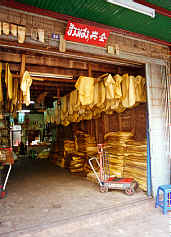 Stores of latex sheets, bought from a number of rubber planters, are brought into town. |
||
|
||
![]()
E-mail us:




